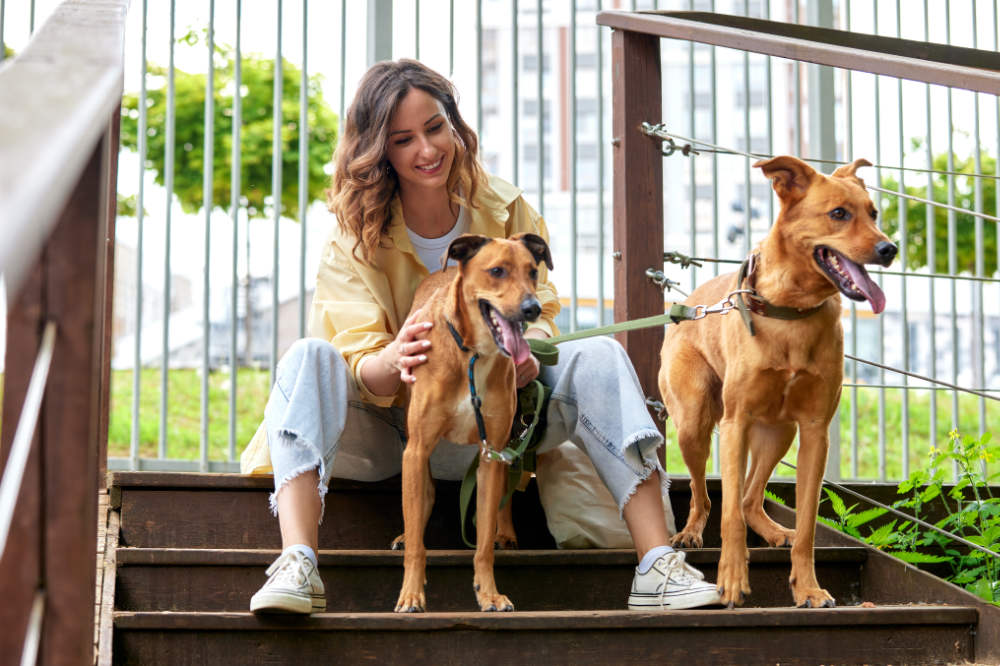
Here at Pup Goes the Easel, you could say that we are dog-mad. Our love of dogs spans decades and this unbreakable bond continues through the generations. Yet, there are still so many misconceptions about dogs that get thrown around. So, if you want to fully understand your dog, read on to discover the top 10 myths about dogs.
1. Myth: Dogs age in human years
There is a common belief that one human year is the equivalent of 7 dog years. Ask any vet and they will tell you that this is simply a rough guide. In truth, dogs age differently depending on different stages of development. A one-year-old dog is not mentally and emotionally developed like a seven-year-old human, they are more like a 15-year-old teenager. Different breeds also age in different ways, small dogs develop faster and live longer lives in comparison to larger breeds.
2. Myth: Only happy dogs wag their tails
Dogs love to communicate with us, whether it is through their charming facial expressions, their goofy ears or their wagging tail. But, a wagging tail doesn’t always signal happiness. In fact, a wagging tail expresses an abundance of emotions, be they happy or stressed. When trying to decipher your dog’s emotional state, it is best to read their body language as a whole. If they are wagging their tail with their ears down and in a position to play – they are happy. Yet if they are in an angular stance, ears pricked up and teeth showing – they are wagging their tail with aggressive intent to warn other dogs.

3. Myth: Dogs see in black and white
When it comes to the top 10 myths about dogs, this is one that we love to myth-bust. It is simply not true. While dogs don’t see in the same technicolour vision as humans do, they also don’t see in black and white. Humans have three types of colour-detecting cells known as cones, while dogs have two types of these cells in their eyes. The result? A muted vision which highlights blue, grey and yellow. It has been known that dogs similarly see the world to someone with red colour blindness. So, next time you want to buy your dog a toy, pick a yellow or blue one so that they can see the colour.
4. Myth: Dogs and cats can’t live together
Of course, this myth is false. Dogs and cats may be different species but it doesn’t mean they can’t get along. Dogs and cats don’t share the same instincts or body language which could prove confusing in the beginning. Yet, with the correct socialisation, training and lots of patience, you will find that both animals can live together in harmony.

5. Myth: Dogs are natural swimmers
As any greyhound owner will know, not all dogs are natural water babies. Labradors, water dogs and many other breeds love a good splash and can easily defend themselves in a large body of water. However, dogs with barrel-shaped chests, short legs or short snouts may find swimming a little more challenging. But, it is not to say it is impossible. It just requires a lot of patience, practice and the correct safety gear such as a life-jacket.
6. Myth: Rubbing your dog’s nose in their mess helps with potty training
Old-school dog training doesn’t take into consideration the positive reinforcement that modern dog training methods do. Potty training is an example of this. It is one of the top 10 myths about dogs that you need to rub your dog’s nose in their accident when potty training to teach them to do their business outside. Instead of training them to alert you that they need to go outside, it only teaches them that you are unpredictable and it creates a negative impact. It is far more effective to stop them in the middle of going to the toilet and redirect them to a designated spot such as a puppy pad then reward them when they finish their toilet duties in the designated spot.

7. Myth: Dogs eat grass to purge themselves
This old wive’s tale is one of the top 10 myths about dogs and one that gets passed from generation to generation. According to the Blue Cross, dogs can enjoy nibbling on grass for many different reasons. Sometimes it can be because they find it tasty, they are bored or because they have an upset stomach. So next time you see your dog nibbling on grass, it could be that they are bored. Just be careful in public places where grass could be treated with weed killers or other toxic chemicals.
8. Myth: A well-trained dog will never bite
At the end of the day, dogs are instinctive animals and put in a situation where they feel fear or stress could result in aggressive behaviour. It is impossible to say that a dog will never bite, even if they have never shown signs of aggression before in their lives.

9. Myth: You can not teach an old dog new tricks
A common misconception about older dogs is that they are set in their ways. While a puppy will speedily learn new tricks and skills, it may take older dogs longer to grasp the concept. But, it is entirely possible to teach an old dog new skills, just make sure to be consistent in your training efforts and don’t forget to reward them with a treat in the end.
10. Myth: Rescue dogs are hard to train and don’t make good pets
This is the biggest myth of them all. As avid rescue dog owners, we can safely say that this is simply not true. There are many cases of rescue dogs becoming life-long family pets and a great source of happiness. When adopting a dog it is important to do your research and think about your family set-up and lifestyle not just now but how it will change in the future. The rescue shelter will be able to make an informed decision about which dog is right for you based on your criteria and the dog’s background. Not all rescue dogs are suitable for homes with small children for example, or homes with cats. It requires a skilled canine matchmaker but rescue dogs make wonderful pets and best of all, you are giving them a forever home.
